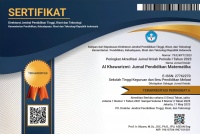KEMAMPUAN KOMUNIKASI MATEMATIS DITINJAU DARI GENDER PADA SISWA KELAS VIII SMPN 11 PONTIANAK
DOI:
https://doi.org/10.46368/kjpm.v4i2.2329Abstract
Abstrak: Kemampuan komunikasi dalam matematika dikenal dengan kemampuan komunikasi matematis yang harus dimiliki siswa selama belajar dalam pembelajaran matematika. Komunikasi matematis tidak terlepas dari perbedaan gender. Berdasarkan hasil pra-obeservasi bersama Guru Matematika kelas VIII SMP Negeri 11 Pontianak diperoleh informasi bahwa siswa perempuan lebih cendrung memiliki kemampuan komunikasi matematis yang baik dibandingkan siswa laki-laki, namun mereka rata-rata cenderung lebih unggul dari pada siswa perempuan dalam tes visual ruang. Hasil dari penelitian ini diperoleh ketercapaian komunikasi matematis siswa perempuan lebih unggul terhadap siswa laki-laki dalam kemampuan menyusun pertanyaan terhadap situasi yang diberikan disertai alasan. Adapun beberapa hasil tersebut juga didukung dari perhitungan uji-t dapat dilihat bahwa hasil uji-t hitung adalah 2,1212 dari nilai tersebut bahwa thitung > ttable , maka dapat disimpulkan bahwa terdapat perbedaan signifikan dari komunikasi matematis siswa perempuan dan laki-laki.
Â
Kata Kunci: Kemampuan Komunikasi, Matematis, Siswa
Â
Abstract : Communication skills in mathematics are known as mathematical communication skills that students must have while studying mathematics. Mathematical communication cannot be separated from gender differences. Based on the results of pre-observations with the Class VIII Mathematics Teacher at SMP Negeri 11 Pontianak, information was obtained that female students were more likely to have good mathematical communication skills than male students, but on average they tended to be superior to female students in the spatial visual test. The results of this research showed that female students' mathematical communication achievements were superior to male students in their ability to formulate questions about given situations with reasons. Some of these results are also supported by t-test calculations. It can be seen that the calculated t-test result is 2.1212. From this value, tcount > ttable, it can be concluded that there is a significant difference in the mathematical communication of female and male students.
Â
Keywords: Communication Skills, Mathematical, Student.References
Arikunto, S. 2010. Prosedur Penelitian Suatu Pendekatan Praktik. Jakarta: PT Rineka Cipta.
Azhari, D. N. (2018). Analisis Kemampuan Komunikasi Matematis Siswa SMP Berdasarkan Gender Dan Self Concept. JPMI (Jurnal Pembelajaran Matematika Inovatif), 1(2), 129- 138.
Firawati, N. A. (2019). Kemampuan Komunikasi Matematis Siswa Kelas VIII Pada Materi Statistika Ditinjau Dari Perbedaan Gender Di SMP Negeri 5 Pallangga [Skripsi]. Makasar: Universitas Muhammadiyah Makassar. Diperoleh dari https://digilibadmin.unismuh.ac.id/upload/8819-Full_Text.pdf
Jazuli, A. (2009). Berpikir kreatif dalam kemampuan komunikasi matematika. Jurmal In Prosiding Seminar Nasional Matematika dan Pendidikan Matematika Jurusan Pendidikan Matematika FMIPA UNY, 2 (3), 209-220.
Lestari, K. E. (2015). Penelitian pendidikan matematika. Bandung: PT Refika Aditama.
National council Of Teacher Of Mathematics Leadership. (2000). Principles and Standarts For School Mathematics. United States Of Amerika.
Prayitno, S. (2013). Komunikasi Matematis Siswa SMP dalam Menyelesaikan Soal Matematika Berjenjang ditinjau dari Perbedaan Gender. E-Journal Prints@UNY, 9(4), 978-979.
Sugiyono. (2017). Metode Penelitian Pendidikan Pendekatan Kuantitatif, Kualitatif dan R&D. Bandung: CV Alfabeta.
Verawati. (2020). Kemampuan Komunikasi Matematis Siswa Ditinjau Dari Motivasi Belajar Pada Materi Himpunan Di SMP Negeri 14 Pontianak [Skripsi]. Pontianak : Universitas Tanjungpura.
Downloads
Published
How to Cite
Issue
Section
Citation Check
License
Authors who publish with this journal agree to the following terms:
1. Authors retain copyright and grant the journal right of first publication with the work simultaneously licensed under a Creative Commons Attribution License that allows others to share the work with an acknowledgement of the work's authorship and initial publication in this journal.
2. Authors are able to enter into separate, additional contractual arrangements for the non-exclusive distribution of the journal's published version of the work (e.g., post it to an institutional repository or publish it in a book), with an acknowledgement of its initial publication in this journal.
3. Authors are permitted and encouraged to post their work online (e.g., in institutional repositories or on their website) prior to and during the submission process, as it can lead to productive exchanges, as well as earlier and greater citation of published work.






